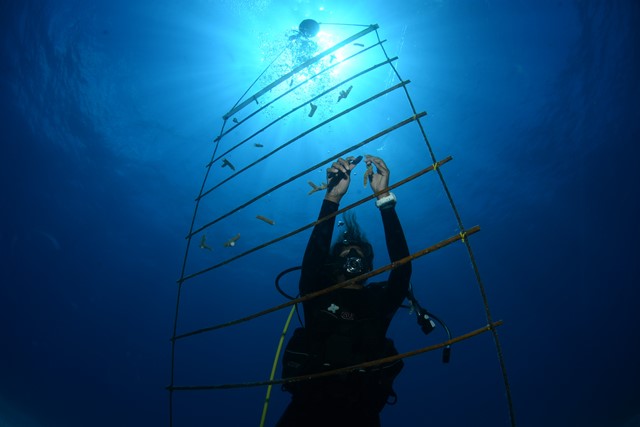
COLE BAY – The St. Maarten Nature Foundation has started to populate its first coral nursery structures last week in an attempt to repopulate depleted reefs around the island with rare coral species.
“The first Staghorn corals (Acropora cervicornis) have been transplanted to the coral nursery station on the dive site ‘the Bridge,’ close to Simpson Bay. The two nursery ladders from the Nature Foundation are now populated with coral fragments in order to raise new coral colonies to repopulate the coral reefs,” Nature Foundation said in a statement.
“In the next months, more nursery ladders will be placed and populated with Staghorn and also Elkhorn (Acropora palmata) fragments. The coral nursery will be checked and cleaned regularly to prevent algae growth and to secure optimal growth conditions for the corals. Also the growth of the coral fragments will be researched and compared with other Caribbean islands. We are asking scuba divers to keep their distance to the coral nursery as the corals are fragile,” commented Nature Foundation Projects Officer Melanie Meijer zu Schlochtern.
The Coral Nursery Project in St. Maarten is part of the 3-year RESCQ project (Restoration of Ecosystem Services and Coral Reef Quality) funded by the European Union (EU) Best 2.0 Program.
The Nature Foundation is collaborating with IMARES Wageningen UR, the Saba Conservation Foundation, Stenapa St. Eustatius, and the Turks and Caicos Reef Fund to restore coral reefs on St. Maarten, Saba, St. Eustatius and the Turks and Caicos islands. The project will restore Elkhorn (Acropora palmata) and Staghorn (A. cervicornis) coral reef zones by establishing a coral nursery on each of the four islands to grow coral fragments and transplantation at selected restoration sites.
The Nature Foundation also received support and expert assistance from Jamaican Coral Restoration Expert Michelle McNaught during the initial stages of populating the fragments. The Foundation also received assistance from Ocean Explorers in populating the first nurseries.




























